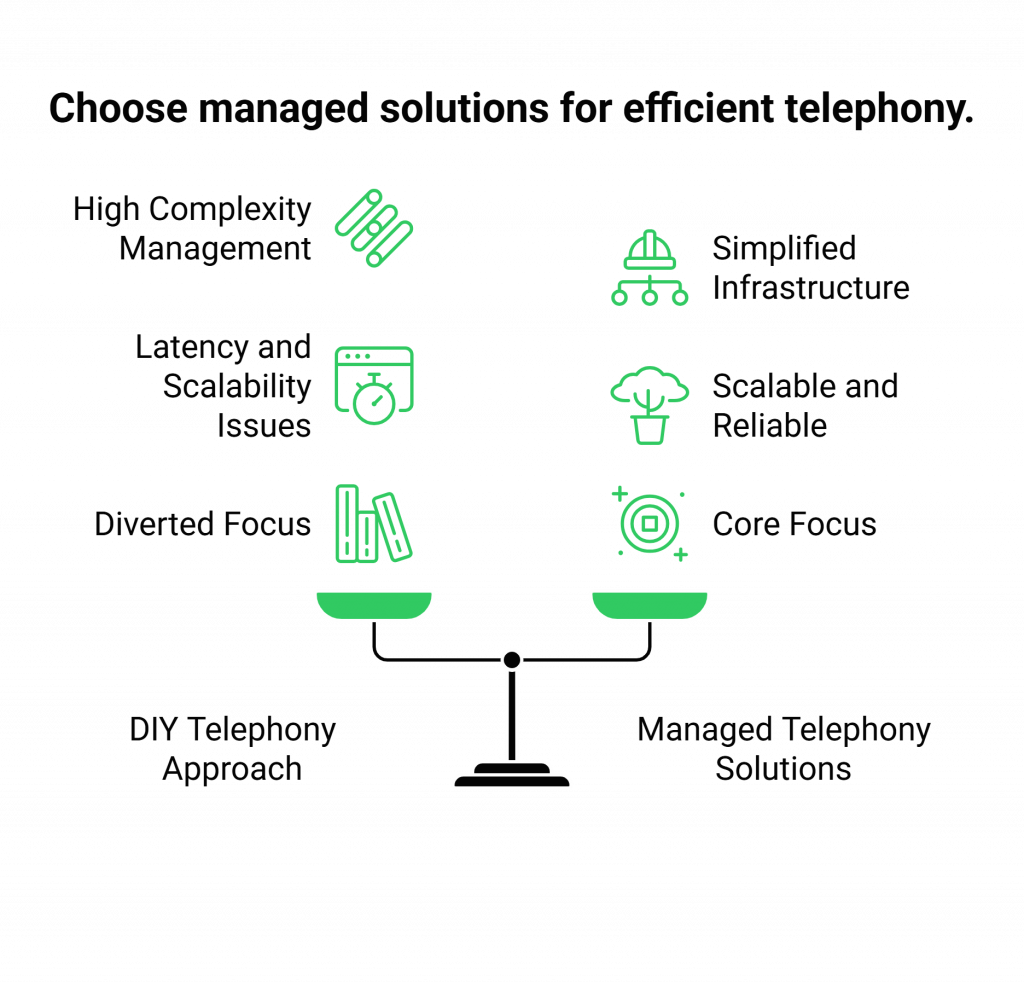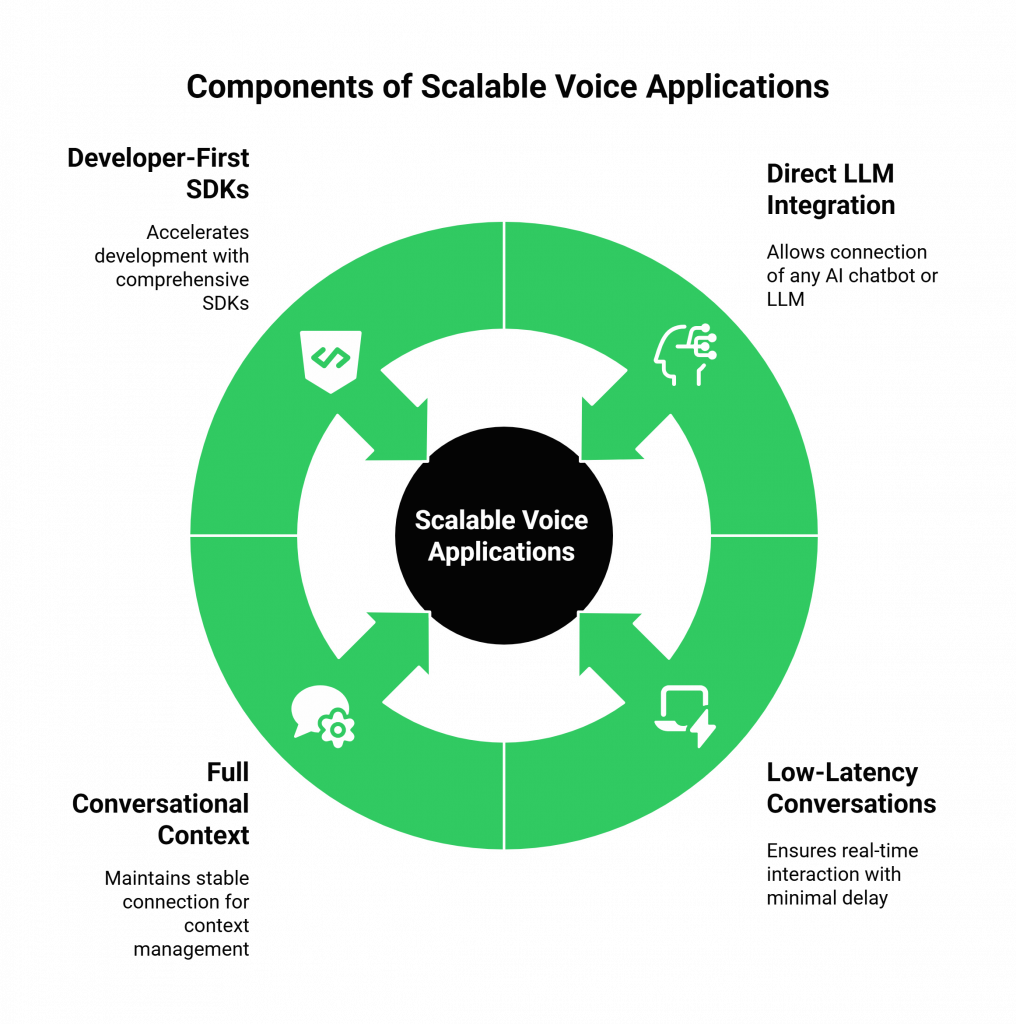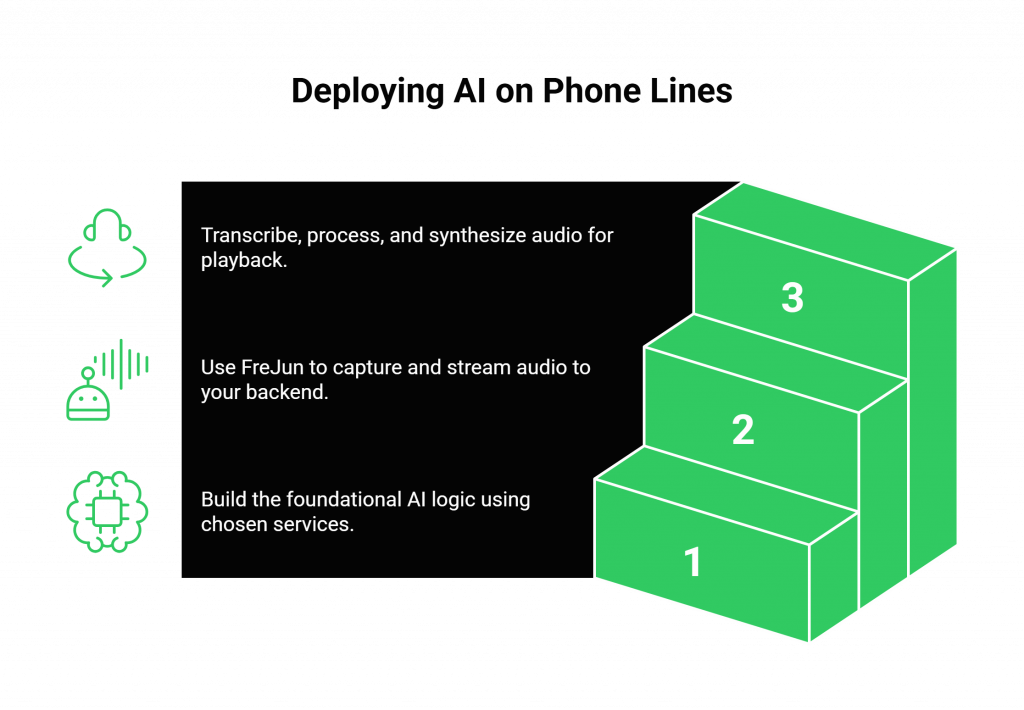Building a smart voice bot is easier than ever until it needs to speak on real phone calls. From managing real-time audio to connecting with phone lines, voice infrastructure is complex and hard to scale. However, FreJun AI solves this problem.
FreJun gives developers powerful APIs to create voice bots that work on web, mobile, and phone calls without the telecom headaches. In this article, we will show how FreJun helps you launch production-grade voice bots, fast.
Table of contents
- The Challenge of Building Production-Grade Voice Bots
- Why the DIY Approach Falls Short for Telephony?
- FreJun: The Voice Infrastructure Layer for Your AI
- A Toolkit for Scalable Voice Applications
- DIY Voice Stack vs. FreJun-Powered Voice Agent: A Comparison
- How to Deploy Your AI on Phone Lines with FreJun: 3 Core Steps?
- Final Thoughts: Move from Concept to Conversation with Confidence
- Frequently Asked Questions
The Challenge of Building Production-Grade Voice Bots
Developers and product leaders are eager to deploy AI-powered applications that interact with users through spoken language. The goal is ambitious yet clear: create intelligent, responsive voice bots that can automate customer service, qualify leads, or handle complex queries across web, mobile, and telephony platforms.
The building blocks for the “brain” of such a bot are more accessible than ever. With powerful Large Language Models (LLMs) from OpenAI, conversational intelligence platforms like Google Dialogflow, and a host of Speech-to-Text (STT) and Text-to-Speech (TTS) services, crafting the core logic seems straightforward. Frameworks like React Native even promise a single codebase for web and mobile deployment.
But this is where a critical gap emerges. While you focus on perfecting your AI’s conversational flow and response quality, a much larger, more complex challenge is often overlooked: the underlying voice infrastructure. How do you reliably connect your AI brain to a live, real-time phone call? How do you manage the bidirectional audio stream with minimal latency to avoid awkward pauses? And how do you scale this from a single test call to thousands of concurrent conversations without compromising clarity or stability?
Why the DIY Approach Falls Short for Telephony?
Building a voice bot using a collection of separate APIs one for STT, another for the LLM, and a third for TTS presents a significant engineering hurdle. This do-it-yourself approach requires your team to become experts in multiple domains that fall far outside of core AI development.

Here’s where the typical DIY stack begins to crumble, especially when moving beyond a simple web interface to real-world telephony:
- Managing Real-Time Audio Streams: A phone call isn’t a simple HTTP request. It’s a persistent, bidirectional stream of raw audio data that must be captured, transported, processed, and returned in milliseconds. Managing this low-latency stream is fundamentally different and vastly more complex than handling text-based API calls.
- Telephony Infrastructure Complexity: Connecting your application to the Public Switched Telephone Network (PSTN) involves a mountain of complexity. You have to deal with SIP trunks, telecom carrier negotiations, number provisioning, and regulatory compliance (like TDRA or DoT), which vary dramatically by region.
- Latency and Conversational Flow: The user experience of a voice bot lives and dies by its responsiveness. Awkward delays between a user speaking and the bot responding break the conversational flow and erode trust. Stitching together separate STT, LLM, and TTS services often introduces cumulative latency that makes for a stilted and unnatural interaction.
- Scalability and Reliability: How does your DIY solution handle 100 simultaneous calls? Or 1,000? Scaling voice infrastructure requires geographically distributed servers, redundant systems, and sophisticated load balancing to ensure high availability and clear audio quality, a massive undertaking for any in-house team.
- Diverted Focus: Every hour your engineering team spends troubleshooting SIP connectivity, optimizing audio codecs, or managing telecom provider relationships is an hour they aren’t spending on what truly differentiates your product: the intelligence of your AI.
FreJun: The Voice Infrastructure Layer for Your AI
This is precisely the problem FreJun was built to solve. We believe your team should focus on building the best possible AI, not wrestling with the intricacies of voice infrastructure. FreJun provides the robust, reliable, and low-latency voice transport layer that connects your AI to the global telephone network.
Think of it this way: Your AI is the brain. FreJun is the nervous system.
We handle the complex telephony, real-time media streaming, and call management so you can simply plug your existing STT, LLM, and TTS services into our platform. Our architecture is designed for one purpose: to turn your powerful text-based AI into a powerful, production-grade voice agent that can handle real-world phone calls at scale.
FreJun is model-agnostic. Whether you use OpenAI, Dialogflow, Amazon Lex, or a custom-built model, our API serves as the reliable transport layer. You maintain full control over your AI logic and conversational state while we ensure every word is captured and delivered with speed and clarity.
Also Read: Remote Team Communication Using Softphones for SMB Success in Thailand
A Toolkit for Scalable Voice Applications
FreJun provides everything you need to move from a proof-of-concept to a production-grade voice AI, backed by robust infrastructure and developer-first tooling.

Direct LLM & AI Integration
Bring your own AI. Our API is fundamentally model-agnostic, allowing you to connect any AI chatbot or Large Language Model. You send us the raw audio from your TTS service, and we play it back over the call. We stream the caller’s audio directly to your application for processing by your chosen STT service. This ensures you maintain full and complete control over your AI logic, context management, and conversational flow while we manage the voice layer.
Engineered for Low-Latency Conversations
Natural conversation requires real-time interaction. At our core is a real-time media streaming engine. Our entire technology stack is optimized to minimize the round-trip latency between the user speaking, your AI processing the request, and the voice response being heard. This focus on speed eliminates the awkward, unnatural pauses that plague so many automated voice systems and break the conversational flow.
Enable Full Conversational Context
A successful conversation depends on context. FreJun’s platform acts as a stable and persistent transport layer for your voice AI. By maintaining a stable connection throughout the call, we provide a reliable channel for your backend application to track and manage conversational context independently. Your application maintains full control over the dialogue state, allowing for more sophisticated and human-like interactions.
Developer-First SDKs
We are built for developers who need to ship reliable products quickly. Our comprehensive client-side and server-side SDKs accelerate development, allowing you to easily embed voice capabilities into web and mobile applications or manage call logic entirely on your backend.
DIY Voice Stack vs. FreJun-Powered Voice Agent: A Comparison
Choosing the right architecture is critical. The following table contrasts the common challenges of a DIY approach with the streamlined solution FreJun provides for creating telephony-based voice bots.
| Feature / Challenge | DIY (Do-It-Yourself) Stack | FreJun-Powered Voice Agent |
| Telephony Integration | Requires sourcing and managing SIP trunks, dealing with multiple carriers, and handling complex network protocols. | Managed, production-grade telephony infrastructure provided out-of-the-box. No SIP expertise needed. |
| Latency Management | High potential for cumulative latency from chaining separate STT, LLM, and TTS API calls, leading to awkward pauses. | Entire stack is optimized for low-latency, real-time media streaming, ensuring natural conversational flow. |
| Scalability | Scaling to handle thousands of concurrent calls requires significant in-house engineering for load balancing and infrastructure. | Built on resilient, geographically distributed infrastructure engineered for high availability and enterprise scale. |
| AI Model Flexibility | Locked into the capabilities and limitations of the specific APIs chosen. Switching providers can require a major refactor. | Completely model-agnostic. Bring your own STT, LLM, and TTS services. FreJun acts as the transport layer. |
| Development Focus | Engineering time is split between building the core AI logic and managing complex voice infrastructure. | Developers focus 100% on the AI application and conversational design. FreJun handles the voice plumbing. |
| Reliability & Uptime | System reliability is dependent on the uptime of three or more separate services and your own custom integration code. | Guaranteed uptime and reliability, backed by a platform designed for mission-critical enterprise applications. |
| Support | No single point of contact for support. Issues could be with STT, TTS, LLM provider, or your own code. | Dedicated integration support from experts, from pre-integration planning to post-launch optimization. |
Also Read: Remote Team Management with Softphones for Professional Operations in Sweden
How to Deploy Your AI on Phone Lines with FreJun: 3 Core Steps?
The technical documentation for building simple voice bots often details a multi-step process involving client-side libraries and direct API calls. However, to deploy a truly robust voice agent on the telephone network, the process is simpler and more powerful with FreJun. You build the brain; we provide the connection.

Here is the modern, streamlined workflow:
Step 1: Develop Your Conversational AI Core
This part remains your domain. Using the tools and platforms you trust, construct your AI’s core logic.
- Choose Your STT Service: Select a Speech-to-Text provider that best fits your needs for accuracy and language support.
- Choose Your LLM/NLU Engine: Implement your conversational logic using OpenAI, Google Dialogflow, Amazon Lex, or your own proprietary models. This is where you’ll define intents, manage dialogue, and generate text-based responses.
- Choose Your TTS Service: Select a Text-to-Speech provider that delivers the voice, tone, and clarity you want for your brand.
At the end of this step, you should have a functional, text-based AI accessible via an API endpoint on your backend.
Step 2: Stream Voice Input with FreJun
This is where FreJun replaces the complexity of DIY audio capture. Instead of wrestling with browser or mobile microphone permissions, you use a single, powerful API.
- An inbound or outbound call is initiated via the FreJun platform.
- Our API captures the caller’s speech in real-time.
- We stream this raw audio data with low latency directly to your backend application endpoint.
Your application receives a clean audio stream, ready for processing, without any of the traditional telephony overhead.
Step 3: Process with Your AI and Stream Voice Response Back
With the audio stream in hand, your backend orchestrates the conversation and completes the loop.
- Transcribe: Your backend sends the audio stream from FreJun to your chosen STT service to get a text transcription.
- Process: The transcribed text is sent to your LLM/NLU engine, which processes the input and generates the appropriate text response.
- Synthesize: The text response from your AI is sent to your chosen TTS service, which returns the response as an audio file or stream.
- Respond: You simply pipe this resulting response audio from your TTS service back into the FreJun API. We handle the immediate, low-latency playback to the user over the phone line.
This elegant loop allows you to create highly responsive and intelligent voice bots without ever touching the underlying complexity of a phone call.
Also Read: Virtual PBX Phone Systems Implementation for Businesses in South Africa
Final Thoughts: Move from Concept to Conversation with Confidence
The ability to create cross-platform voice bots with API control is no longer a futuristic vision; it is a present-day strategic necessity for businesses aiming to enhance customer experience and operational efficiency. However, the path to success is not paved with a patchwork of disparate APIs and complex, self-managed infrastructure. That approach is a drain on resources, a risk to reliability, and a distraction from your primary goal.
The most effective strategy is to decouple the AI brain from the voice transport system. Let your team pour its energy into building unique, intelligent conversational experiences. Let FreJun provide the enterprise-grade foundation to deliver those experiences over the most trusted and universal communication channel: the telephone.
By handling the complex voice infrastructure, we empower you to deploy sophisticated, real-time voice agents in days, not months. You bring the intelligence; we bring the connection.
Further Reading – Power Dynamic Conversations with a Talking Voice Bot API
Frequently Asked Questions
No. FreJun is not an AI or LLM provider. Our platform is model-agnostic and designed to work with any AI service you choose. We provide the critical voice transport layer that connects your AI to the telephone network, allowing you to bring your own intelligence.
Yes. FreJun’s value is in providing the real-time media streaming and call management infrastructure. You maintain full control and flexibility by bringing your own STT and TTS providers, ensuring you can choose the best-in-class services for your specific needs regarding language, accent accuracy, and voice quality.
While our SDKs can help embed voice capabilities into applications, FreJun’s core strength is solving the immense complexity of real-time voice over the global telephone network (PSTN). A web interface handles audio in a controlled browser environment; FreJun manages the chaos of telco carriers, SIP protocols, and low-latency streaming required for professional, scalable voice agents that work on any phone.
No. FreJun is a complete voice communication platform. We manage the entire lifecycle of a call, including the persistent, bidirectional, low-latency audio stream. This allows for truly interactive conversations, not just one-way audio playback.
With our robust API, comprehensive SDKs, and dedicated integration support, you can connect your existing AI and launch sophisticated, real-time voice agents in days, a process that would otherwise take many months to build from scratch.
